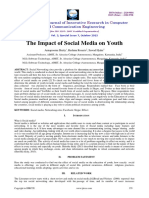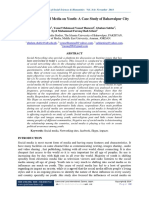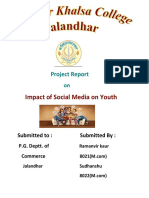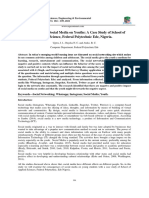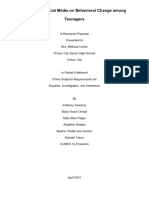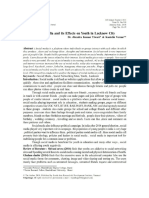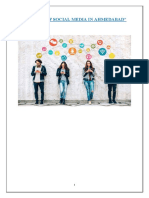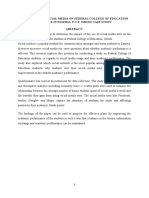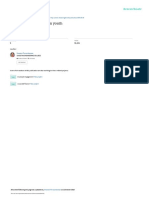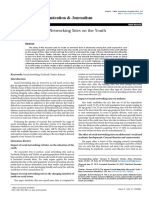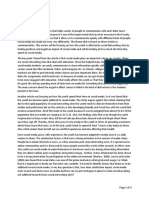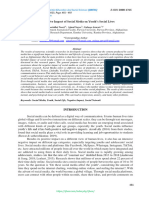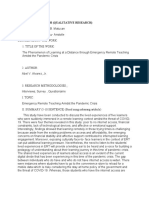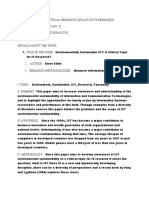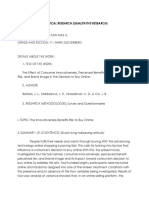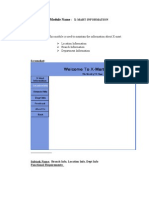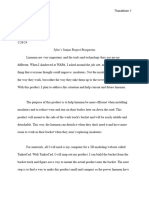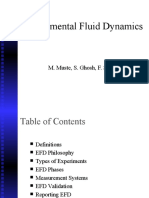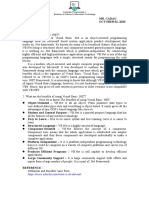PRACTICAL RESEARCH
NAME : ANGEL M. CABRITO
GRADE & SECTION : 11 – ADA LOVELACE (ICT)
DETAILS OF THE WORK
TITLE OF THE WORK : A case study of The Impact of Social Media.
AUTHOR : Ghulam Shabir[1] , Yousef Mahmood Yousef Hameed[2] , Ghulam Safdar[3] , Syed
Muhammad Farouq Shah Gilani[4]
RESEARCH METHODOLOGIES : Descriptive Research – Survey
I. TOPIC :
The impact of Social Media on Youth : A case study of bahawalpur city.
II. SUMMARY
Social Networking sites provide a platform for discussion on burning issues that has been overlooked in
today’s scenario. This research is conducted to check the impact of social networking sites in the
changing mind-set of the youth. It is survey type Research and data was collected through the
questionnaire. 300 sampled youth fill the Questionnaire, while non-random sampling techniques was
applied to select ssample units. Rate of return was remaining 97 percent after fill up the questionnaire.
The main objectives were as (1) To analyze the influence of social media on youth social life (2) To assess
the beneficial and preferred form of social media for youth (3) To Evaluate the attitude of youth towards
social media and measure the spending time on social media (4) To recommend some measure for
proper use of social media in right direction to inform and educate the people. Collected data was
analyzed in term of frequency, percentage, and mean score of statements. Findings show that the
majority of the respondents show the agreements with these influences of social media. Respondents
opine Face book as their favorite social media form, and then the Like Skype as second popular form of
social media, the primary place for them, 46 percent responded connect social media in educational
institution computer labs, Mainstream responded as informative links share, respondents Face main
pproblem during use of social media are unwanted messages, social media is beneficial for youth in the
field of education, social media deteriorating social norms, social media is affecting negatively on study
of youth. Social media promotes unethical pictures, video clips and images among youth, anti-religious
post and links create hatred among peoples of different communities, Negative use of social media is
deteriorating the relationship among the countries, social media is playing a key role to create political
awareness among youth
� III. HYPOTHESES
1. It is likely to say that Social media is creating awareness for youth in better leaving style.
2. It is likely to say that Social media is swift source of information and entertainment for
youth’s interest.
3. It is likely to say that Social media is great facilitator for youth in the field of Education.
4. It is likely to say that youth is utilizing social media in positive way.
5. It is likely to say that social media is really helpful for the youth.
IV. METHODOLOGY
The descriptive method was used to carry this study. And survey type research was conducted, through
the questionnaire public opinion and perception was discriminate about the impact of social media on
youth and statements was developed related to the various aspect of youth’s life and society. Collected
data was analyzed in term of frequency, percentage, and mean score of statements. This research is
conducted to check the impact of social networking sites in the changing mind-set of the youth. This
research was conducted using survey.
V. FINDINGS
This research finds that the excessive users in the educational computer labs use the social media forms
for comments, chatting, image and video sharing and texting etc. This average touches the almost half
of the sampled population. This shows that they ignore their primary focus on their study and research
related activities while utilizing the facility of internet in connecting with their friends on the social
media networking forums with their average utilized time between 30 to 60 minutes. But the actual
results may cross this maximum time period while utilizing the social media forms as 13 percent
responded that they use it more than 2 hours in a single day. Their important features while using social
media are SMS, video clips sharing links and comments. The informative links and the Islamic links are
widely shared by the sample population of this survey for the fellow users. The users mostly face
problems such as unwanted messages, unwanted friends request and controversial political links and
unethical pictures and links, irrelevant religious and anti-religious messages and useless information.
Despite agree with the argument that social media is affecting the life of the youth, the sampled youth
population is continuously using the social media forms in all the Pakistan including in rural areas where
the internet facility is available. It has deliberately affected the physical and sports activities which is
being replaced by social media.
VI. ERRORS STRENGTH OR WEAKNESSES
The research was very clear and easy to understand. They really did a survey just to know every youth’s
POV in this kind of topic. I can’t complain anything because their research is completed, as in all
information needed is there. They even put a chart so that they can show how the survey is going. This
research was detailed and clear.
VII. REFERENCE
[1] Aamoth. D. (2011). Brief History of Skype. New York: Oxford University Press.
[2] Ahn, J. (2012). Teenager and social network sites do of line inequalities predict their on line social
networks. USA: University of Maryland.
�[3] Balousha, H. (2013). Palestian Youth on Social Media. Gaza Publications.
[4] Barneys, S. (2012). Effects of social media on employees, New York: Tag Archive.
[5] Basit, A. D. (2013). Side Effects of Social Media and Pakistani Young Generation Pakistan: Pakistan
News.
[6] Bassem, E., & Maamari. E.B, (2013). The Impact of Social Media on the Political Interests of the Youth
in Lebanon, Lebanon: Hala El Zein Published.
[7] Beattie, A. (2013). Social media and its effects on our emotional well being. Canada: INSIGHT Planner
at Metro and Freelance Film Journalist.
[8] Berkman, S. (2007). Why youth hearts social network sites, Berkman Center for Internet and Society,
Harvard University, USA.
[9] Blumler, J. G., & Katz, E. (1974). The uses of mass communications: Beverly Hills, CA. Sage.
[10] Brenner, J. (2013). Online adults use social networking sites, USA: Pew Internet.
[11] Carlson, N. (2010). At Last The Full Story of How Facebook Was Founded, USA: Business Insider.
[12] Chmielewski et al., (2009). How MySpace fell off the pace, USA: Los Angeles Times.
[13] Dan, S. (2013). The hidden impact of social media. USA: Bigger Big Data Dan Sandler.
[14] DeLisi, P.S. (2012). The Harmful Effects of Social Networks and Other Electronic Media, Santa Clara
University.
[15] Elaheebocus, R. M. S. (2013). Impact of online social networking on Youth: Case Study of Mauritius,
Engineering Department University of Mauritius
[16] Eric, E. (2008). Growth Puts Facebook in Better Position to Make Money, Venture Beat, San
Francisco.
[17] Fields, M. (2013). Social Media’s Impact on Youth, USA: Middle East Study.
[18] Fotis, J., et al., (2011). The impact of social media in consumer behavior, USA: Bournemouth
University.
[19] Goes, D. (2011). An Introduction to Skype. USA, Oxford University Press.
[20] Grube, B. (2012). Social media’s influence on youth, USA: Youth development Initiative, Research
Brief No: 17
[21] Hurley, C. (2007). News Interview, UK: BBC News.
[22] Khan, S. (2012). Impact of Social Networking Websites on Students, Pakistan. Abasyn Journal of
Social Sciences, 5(2), 56.
[23] Khedo, K. K. M. (2013). Impact of online social networking on youth, case study of Computer science.
Mauritian Publications.
�[24] Kordkheili, G. F. Et al., (2013). The Impact of Social Media on Medical Professionalism, J Med
Internet.USA
[25] Lacter, M. (2006). My Space is not their space anymore. New York: Oxford University Press.
[26] Lenhart, A. (2009). Teens and Social Media an Over view. New York: Department of Health & Mental
Hygiene, USA.
[27] McQuail, D. (2005). Mcquail mass communication theory. New Delhi: Vistar Publication.
[28] Merolli et al. (2013). Health outcomes and related effects of using social media in Chronic disease
management. Australia: The University of Melbourne.
[29] Rey, J. (2013). Social Media in Higher Education. USA: Research Publication.
[30] Rubin et al. (2005). Communication Research: Strategies and Source. Canada: Thomson Wadsworth.
[31] Rubin et al. (2005). Communication research strategies and source. Canada: Thomson Wadsworth.
[32] Schurgin, G., et al., (2011). Clinical report: impact of social media on children, Adolescents and
Families Pediatrics 127, 803.
[33] Sun Online Archive, (2007). YouTube and moral panics, The Sun Online Archive.
[34] Sutter, D. J. (2010). Praise for MySpace’s new look – but that logo? UK: CNN.
[35] The Prevention Researcher, (2010). Social Media & Youth, Canada: Brooke Lusk.
[36] Turgeon, K. J. (2011). How Facebook and Social Media Affect the Minds of Generation, California:
The Huffington Post.
[37] Warraich, H. (2011). Pakistan’s social media landscape. Pakistan: Ashan Publications.
[38] Young Academic, (2011). The Death of MySpace. USA.
[39] Zaltzman, J., & Leichliter, B. (2013). Social Media-Related Qualitative Research, China.
